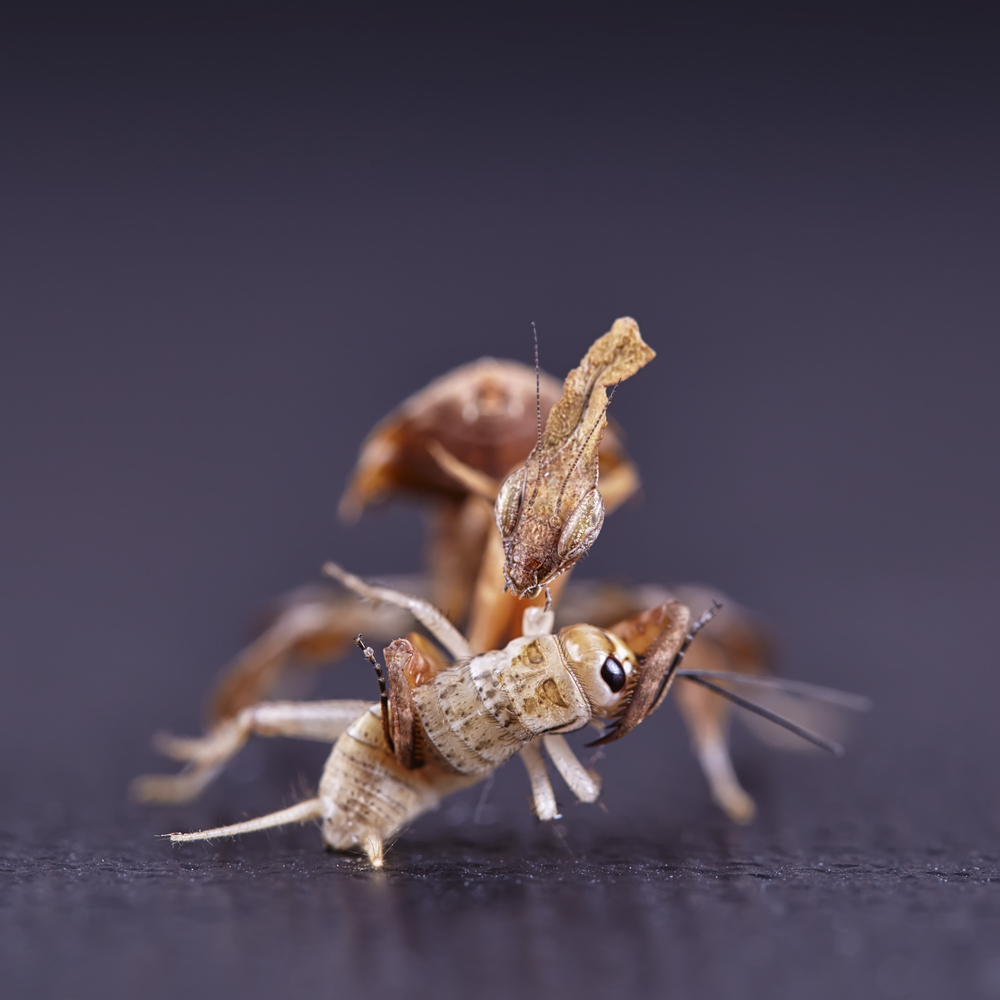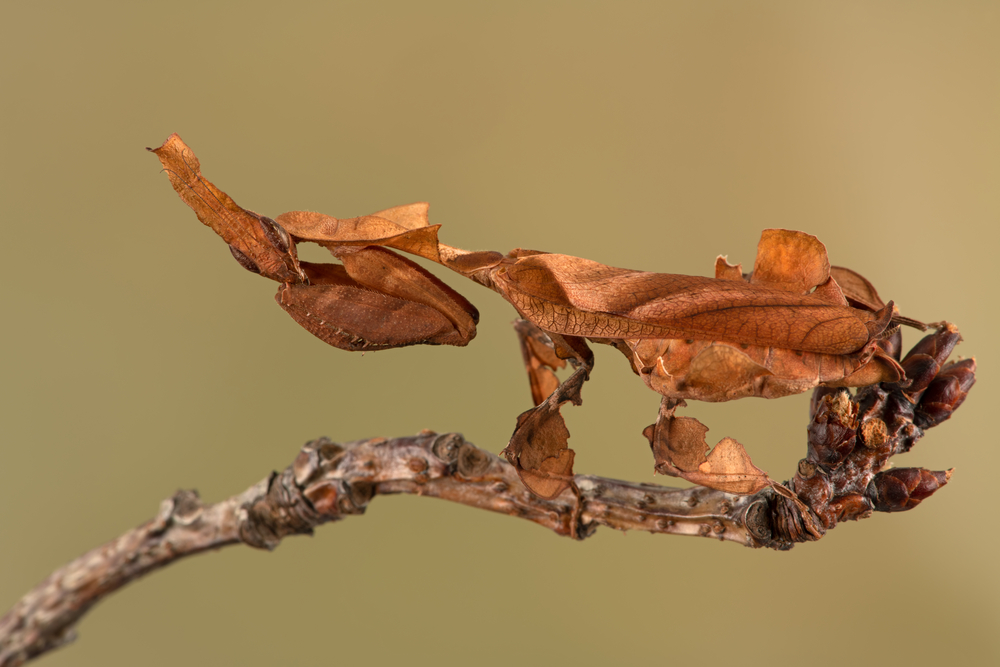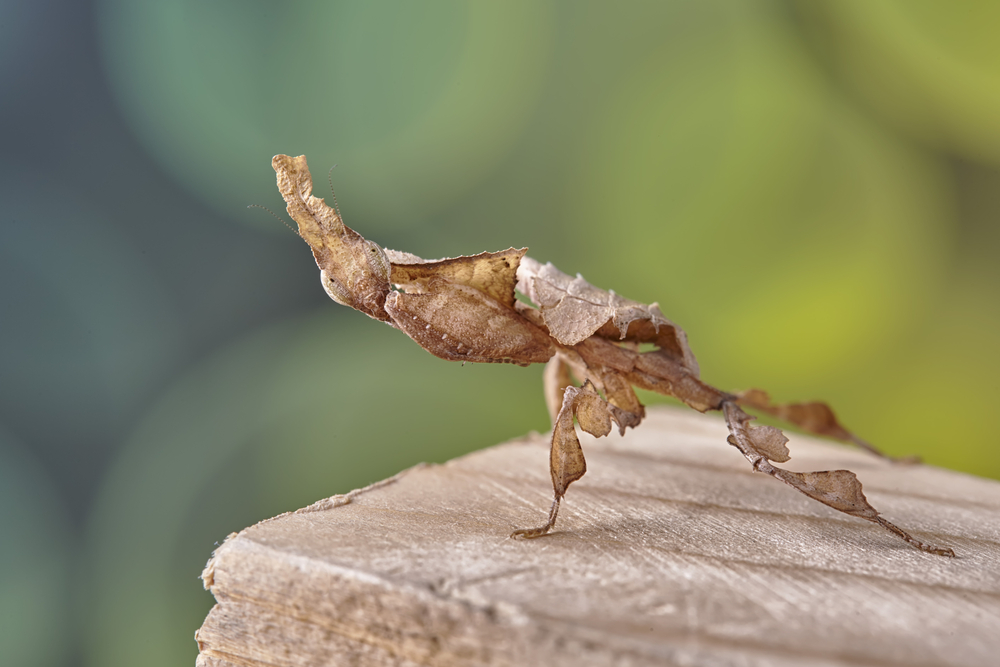The Ghost Mantis is an exciting and stunning species of Phyllocrania paradoxa. The Ghost Mantis originates in Eastern and Western Africa, sometimes in the south, and Madagascar. Ghost Mantis live in dry areas, in bushes, shrubs, and trees. It is one of the smaller species of Mantis.
- Species: Phyllocrania paradoxa
- Diet: Small insects
- Hydration: Misting
- Habitat: Glass or screen enclosure
- Temperature: Friendly
- Lifespan: Approximately 8 months
- Size: 2”
- Care Level: Easy
- Compatibility: Can raise males and females together if well fed
What Is A Ghost Mantis?
So, what exactly is a Ghost Mantis? The Ghost Mantis is small and only grows to about two inches long. In the mantis world, this species is considered to be one of the smallest.
Although many of the Mantis are dark brown, some have colors that range from light sandy brown to a lovely green. It’s been suggested that the color change may be caused when molting because of the response to the amount of humidity. Less moisture tends to produce more brown mantids, while more moisture produces more green Mantis.
Housing for Ghost Mantis
When choosing housing for the Ghost Mantis, the insect needs to be in an enclosure three times as tall as the mantis is in length. But because they are so small, finding a suitable cage usually isn’t a problem. Below are suggestions of what is needed for housing a Ghost Mantis:
Ventilation
Whatever type of enclosure is used, it has to have adequate ventilation. The cage will need, too, material of some kind that will let the mantis hang upside during molting season. Plus, there needs to be a space at the top which is empty that is two times larger than the mantis.
The cages can be made from mesh or from glass. But if you keep the mantis in either of those types of enclosures, a screen or mesh top can be used. Then the mantis can hang upside down with ease.
This species of mantis can be housed in groups of male and female, unlike other mantis species. Cannibalism isn’t a high occurrence for the Ghost Mantis, although it is still a possibility. If there isn’t enough food, the mantis will eat each other. Places to perch are also a necessity.
Cage Size
The cage’s size, as mentioned above, is to be three times taller than the mantis is in length. This is important for the molting process to be completed successfully. Plus, the cage has to have a lid that the mantis can’t escape because they are good at flying and climbing.
If a large colony is going to be kept together, then a larger cage will be needed. This is because if there isn’t enough room to give each mantis personal space, then cannibalism can become an issue.
One of the other main concerns is to be able to keep the cage clean. Hygiene is the key to keeping the mantis healthy and happy. So, choose a container that is easy to keep up with the maintenance.
Décor
What is put inside the cage is as important as what cage is chosen. There are two main concerns when planning the décor for a Ghost Mantis. Perches that are suitable for the insect’s needs are the first consideration.
The number of mantis in the caged environment will affect how many perches are needed. Each mantis should be able to have its own personal perch. The best and easiest perches are just twigs and branches. Immerse them into boiling water, scrub with a detergent that is safe for reptiles, so no pathogens are introduced into the habitant.
The perches need to be positioned so that they touch the ground. This will let the mantis get off the ground if it falls or come down to the ground if it’s hunting. There should be enough space under the twig for the insect to molt with success.
The other concern when planning the décor is what to use on the bottom of the enclosure. Coconut fiber is one substrate that is suitable for adults, and only a small depth is needed. It helps to moderate the humidity, smells good, and looks unique. For young mantis, a simple kitchen towel can be used.
Ghost Mantis Care
The care of the Ghost Mantis isn’t a complicated process because their needs are relatively simple.
Heat Source
Since Ghost Mantis are from the heat of Africa, they will require to have a heat source in their enclosure. For larger specimens of this insect, the whole cage can be heated. 77 degrees-80 degrees Fahrenheit is usually the recommended temperature and is provided by using a heat mat.
If there are young mantids, place all the young into one large cage that is heated. This keeps them all together, and they have an easier time not competing for food with the larger mantids.
With a reptile heat mat, the temperature can be adjusted manually as needed. With a heat mat, it keeps the cage at an even warm temperature and doesn’t harm or disturb the Ghost Mantis’ sleep cycle. It helps keeps the appetite, metabolism, and activity level on point.
Keep in mind that warmer temperatures will shorten the mantis’s life cycle because the heat speeds up the metabolism. Cooler temperatures, on the other hand, will lengthen the life span and slow down metabolism. But extremes of either one of those temperatures can kill the mantis.
Hydration Source
Mantis usually don’t obtain their water from a water source such as a water dish. Plus, there is the danger of them falling in and drowning. Most of the time, the mantis absorb water from their prey. Or they will drink droplets of moisture from the leaves of plants.
So, a lot of the time, using a water bowl is discarded, and misting is used instead. The use of a household spray bottle with lukewarm water should be done about 2-3 times per week. The mist should be a gentle one and not a strong mist.
The misting water can be left to evaporate between the mistings to increase the humidity but not make the cage soggy. The humidity should be in the range of 60-90% for ultimate comfort. Don’t use water from the faucet, but distilled or spring water only.
Plus, mantis don’t enjoy being sprayed with water directly on them. So, try to spray the area around where the mantis is hanging or sitting. If the mantis is sprayed by accident, it’s not a problem. The mantis just doesn’t like it.
Feeding

When it’s feeding time, the Ghost Mantis will eat anything that it can catch and overpower. Because of its small size, the diet of this insect is mostly tiny invertebrates.
When in the wild, the Ghost Mantis will feast mostly on flies and other flying insects. The preferred food to feed the mantis is flies and fruit flies, but it will also eat small grasshoppers, crickets, and other smaller insects.
Prey food should never be bigger than the head of the mantis because their arms don’t have the strength to catch larger insects. Ghost Mantises spend most of their time hanging upside down from the lid of their enclosures or tree branches. This is why prey insects that are on the ground aren’t always and only good food source.
When in the wild, Ghost Mantis are generalists and will attack and eat almost anything within range. It has raptorial claws that will reach out and grasp its victim tightly before devouring it.
Camouflage
The Ghost Mantis uses camouflage techniques to disguise itself from prey and from its predators.
The Body Camouflage
The camouflage of the Ghost Mantis is beyond impressive. Each of the walking legs and abdomen has projections jutting out that look like dead leaves. The thorax is flattened into a leaf-like shape as well.
The back of the insect has thin veins in a lace effect and mottled like the pigmentation of a leaf fold. The insect’s head is the most unique aspect of its whole body.
Because the eyes are the same exact color as the rest of its exoskeleton, the eyes appear almost invisible. Above the eyes is a long crest that resembles a dead, dried, and withered leaf. But it’s just not the physical camouflage that is the whole package.
Behavioral Camouflage
The Ghost Mantis displays camouflage that’s behavioral as well. It will tuck its forelegs up against its body, so the shape is unusual and confusing to predators. On top of that, it will gently rock back and forth like a leaf being blown in a breeze.
Ghost Mantis doesn’t have much in the way of hunting skills. They don’t move much and spend a lot of their time hanging upside on branches and leaves, waiting for lunch to walk by. They hunt by hiding and staying still.
Insects that crawl are the mantis most common prey because of some difficulty capturing prey that flies. A mantis can remain still and in one spot for hours, ready to pounce on anything that comes near. If the mantis feels threatened, it will try to escape or try to fool the predator into thinking the mantis is a leaf.
If those ruses fail, then the mantis plays dead by folding its legs into its body and falling to the ground. Since most predators eat live prey, thinking the Ghost Mantis is dead causes the predator to look elsewhere for its meal.
The Ghost Mantis will also flatten itself against the twig or branch it’s sitting on if feeling threatened. When it does this, the camouflage makes it look like a dead leaf attached to the branch or twig.

Molting
Frequent molting is common with Ghost Mantis. When the mantis are babies, they will molt every 2-3 weeks. Each time between molting will increase as the insect becomes older. Because of this species’ slower growth rate, the last molt before becoming an adult may take up to two months.
Before the Ghost Mantis begins to molt, it will stop eating. So don’t be alarmed if the mantis refuses food. It’s starting to become ready to shed its skin. When the mantis is molting, it’s imperative not to disturb it.
When the molting process begins, the mantis will choose a spot and hang upside down. It may spasm or shake violently, but this is normal behavior. It will slowly worm out of the old skin and then hang and let itself dry. Sometimes a limb may be lost during this process, but if the mantis is young, the limb will grow back.
Breeding Ghost Mantis
To be able to breed Ghost Mantis, the need to be able to tell the male from the female is essential.
Male vs. Female
The males are recognized easily from the females. Both the male and the female Ghost Mantis are about the same size, which is about two inches long.
However, the male has a little bit longer wing case, which is partially transparent and slimmer. The female has six abdominal segments while the male has eight. The colors of these mantes can range from brownish green to appearing almost black.
Plus, the males have long feathery antennae and wings, which are olive in color and almost transparent. The males are excellent flyers and are much thinner than the females.
The female’s wings extend to the end of its abdomen, and they have a prothorax, which is more expansive. After the 6th molt, the female’s crown is as broad as the head. It’s also smoother than the crown of the male.
The female Ghost Mantis becomes an adult after it molts seven times. Then the female will need another two weeks until she can mate. Male Ghost Mantis become mature after it molts six times, so they would be sexually mature about one week before the last molt.
The Breeding Process
The actual breeding is relatively simple as long as the females are well fed. Two weeks after the last molt, the insects should be ready for breeding. The male and females can be placed together unless they are already living in a group.
Be sure to feed the female so she’s distracted and won’t throw him off. Most of the time, the male will sit on top of the female after the initial introduction and mate selection. The Ghost Mantis enclosure needs to be large enough for the male to escape from the female and hide after the mating process.
The male may sit there for a couple of hours without doing anything before making his first attempt. After he holds on for a while, the male bends his abdomen and connects with her abdomen. Then mating will start, and the mating process can take a few days until the male gets enough nerve to do his part.
When the mating is successful, the female, after a few weeks, will start to stick clutches of eggs on the twigs, branches, and enclosure walls. The humidity and temperature should stay the same, being careful the humidity doesn’t rise too much.
The Ootheca
The clutch of eggs is called an ootheca and can have up to 50 eggs, but there are usually 10-40 eggs. There can be about 6 ootheca about 2 inches long. The ootheca is constructed from a protein containing secretion, which is applied to wherever the eggs are located.
The female makes spiral shaped movements with her abdomen, and more of the foamy secretion is released. The egg-laying process begins with one egg being laid after the other within the ootheca.
The secretion looks like a long thread when it’s pulled out and then hardens into a cocoon. The cocoon is firm and sponge-like, with the thinnest wall on the surface where the nymphs will hatch. The appearance looks like a large pore seam.
The Nymphs
At a temperature of about 77 degrees Fahrenheit, the nymphs hatch around at four weeks. They will need to be misted 5-7 times a week. The nymphs can be fed fruit flies about a day or two after hatching.
Nymphs can be housed in the same cage since they aren’t cannibalistic. They will eat copiously until they are filled up. When the Ghost Mantis nymphs hatch, they look like baby ants. This disguise is so the nymphs don’t get eaten by predators.
Spiders and other large insects would love to eat a Ghost Mantis nymph but typically won’t because of this disguise. The nymphs look like black ants, which predators find too aggressive and not tasty to even bother with, so the nymphs are safe. After the second molt, the nymphs will look more like their parents.
Conclusion
Raising Ghost Mantis can be an exciting and rewarding experience. From the first day, they are put into their environment, watching these insects is an adventure. If they breed, then the process from mating, laying of eggs, and then hatching can provide a feeling of accomplishment.
One of the differences between Ghost Mantis from other mantis is that they can live in groups with a rare cannibalism rate. The key is to keep the mantis well-fed, happy, and content in the environment provided for them.
